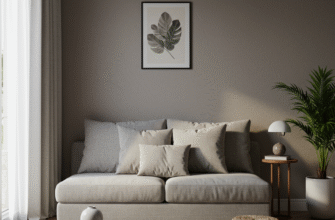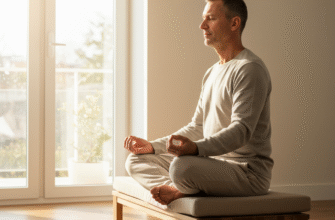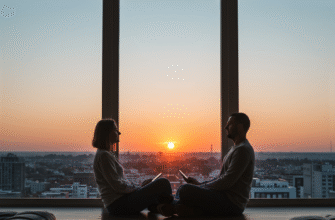Ever feel that spark of creativity fizzle out because you just don’t have the right spot to let it flourish? You’re not alone. Many of us dream of a dedicated space, a sanctuary where ideas can take root and grow without the distractions of daily life intruding. The good news? You don’t need a sprawling mansion or a professional studio setup to make this happen. Your own home, regardless of its size, holds the potential to become your personal creative haven. It’s about carving out a niche, claiming it as your own, and setting the stage for inspiration to strike.
Transforming a part of your home into a creative studio isn’t about spending a fortune; it’s about intentionality. It’s about designating a space, however small, that signals to your brain: “Okay, this is where the magic happens.” It’s a mental shift as much as a physical one. Let’s explore how you can cultivate that perfect creative corner right where you live.
Finding Your Creative Corner
The first hurdle is often figuring out where this magical space will reside. Don’t get discouraged if you don’t have a spare bedroom just waiting to be converted. Think outside the box – or rather, inside corners, closets, and underused areas.
Consider these possibilities:
- The Guest Room Gambit: If you have a guest room that sits empty most of the year, could a portion of it be partitioned off? A folding screen or strategically placed bookshelf can create a visual divide.
- Corner Command Center: An unused corner in a living room, dining area, or even a larger bedroom can become a compact studio. Define the space with a rug or a different wall color.
- Closet Conversion: Walk-in closets aren’t just for clothes! Remove the rod, add a small desk or tabletop, install some shelving and good lighting, and you have a surprisingly effective, distraction-free nook. Even a standard closet can work for certain crafts if you use a rolling cart for supplies.
- Basement or Attic Potential: If you have an unfinished or underutilized basement or attic space, this could be prime real estate. Ensure adequate lighting, ventilation, and temperature control, but these areas often offer more room to spread out.
- The Portable Path: If a dedicated spot is truly impossible, create a “studio in a box.” Use a large container or rolling cart to store all your essential supplies. You can then set up shop temporarily at the dining table or any clear surface when creativity calls, and pack it away neatly afterward.
The key is to choose a location where you feel you can focus, even if it requires some initial setup each time. Look for spots with minimal foot traffic and, ideally, some access to natural light.
Clearing the Canvas: Declutter and Define
Once you’ve scouted your location, the next crucial step is to clear it out. Thoroughly. This space needs to be dedicated to your creative work, not a dumping ground for household clutter. Remove anything that doesn’t serve your creative purpose.
Be ruthless! Old bills, unused gadgets, clothes you meant to donate – they all sap energy and create visual noise. A clean slate physically helps create a clean slate mentally. After decluttering, give the area a good cleaning. Fresh space, fresh start.
Defining the boundaries is also important, especially if your studio is part of a larger room. Use visual cues:
- A distinct rug
- A bookshelf acting as a divider
- Painting the wall(s) within your zone a different color
- Using tape on the floor (a temporary but effective option)
- Arranging furniture to create a clear separation
This helps mentally cordon off the area, making it feel like a distinct zone reserved for creativity.
Clearly defining your creative zone, even with simple visual cues like a rug or a change in wall color, sends a powerful signal to your brain. This demarcation helps you switch into a creative mindset more easily when you enter the space. It reinforces the idea that this area has a specific, dedicated purpose, separate from everyday household activities. Establishing these boundaries can significantly reduce mental clutter and improve focus.
Let There Be Light: Illuminating Your Ideas
Good lighting is non-negotiable for any creative work. Poor lighting strains your eyes, affects your mood, and can even distort color perception if you’re working visually.
Natural Light First: If possible, position your workspace near a window. Natural light is dynamic and has proven benefits for mood and productivity. Consider sheer curtains to diffuse harsh sunlight while still letting light pour in.
Layered Artificial Lighting: You’ll almost certainly need artificial light too. Aim for layers:
- Ambient Lighting: An overhead fixture or a floor lamp provides general illumination for the whole space.
- Task Lighting: This is crucial. A good desk lamp with an adjustable arm and brightness allows you to direct focused light exactly where you need it – on your canvas, keyboard, sewing machine, or notebook. Look for lamps that offer different color temperatures (cool white for focus, warm white for ambiance).
- Accent Lighting: String lights or spotlights can highlight inspirational objects or add a cozy vibe.
Avoid working solely under harsh fluorescent overheads if you can help it; they can feel sterile and draining. Choose bulbs that render color accurately, especially important for visual arts.
Order from Chaos: Smart Storage Solutions
A creative mess is one thing; frustrating clutter is another. When you can’t find the tool or material you need, your flow is broken. Smart organization is key to a functional creative studio.
Think Vertically
When floor space is limited, look up! Wall space is your friend.
- Shelving: Open shelves keep frequently used items visible and accessible. Floating shelves look sleek.
- Pegboards: Incredibly versatile for hanging tools, baskets, small shelves, and containers. Customizable and easy to rearrange.
- Wall Grids: Similar to pegboards, great for clipping notes, inspiration, and lightweight tools.
- Magnetic Strips: Perfect for metal tools like scissors, pliers, or even paint tubes with metal bases.
Containment is Key
Use boxes, bins, jars, and drawers to group similar items together.
- Clear Containers: Let you see contents at a glance.
- Drawer Units: Rolling carts with drawers offer mobile storage that can be tucked away.
- Labels: Label everything! It seems tedious initially, but saves immense time later when you’re searching for that specific shade of blue thread or a particular type of screw.
Keep your primary work surface as clear as possible. Store items you use less frequently further away or higher up. Regularly purge supplies you no longer use.
Comfort and Inspiration: Making it Yours
Your creative studio should be a place you want to spend time in. Comfort and personalization are vital.
The Right Seat: If you sit for long periods, invest in a comfortable, ergonomic chair. Your back will thank you. Even if it’s just a stool for occasional sketching, ensure it’s the right height for your work surface.
Personal Touches: This is your space. Surround yourself with things that inspire you:
- Artwork: Display your own creations or pieces by artists you admire.
- Mood Board: A corkboard or magnetic board to pin inspiring images, color palettes, fabric swatches, or quotes.
- Plants: Greenery adds life, improves air quality, and can boost mood. Choose low-maintenance options if you don’t have a green thumb.
- Color: Incorporate colors that energize or soothe you, depending on your preference and creative work.
- Music: Have a small speaker or headphones ready for your creative soundtrack.
The goal is to create an environment that feels welcoming, stimulating, and uniquely yours. It should reflect your personality and your creative passions.
Taming Distractions: Staying Focused at Home
Working creatively at home comes with built-in challenges: laundry beckons, snacks call, family members or roommates interrupt. Setting boundaries is essential.
Communicate: Let others in your household know that when you’re in your studio space, you need focused time. Agree on signals or specific “do not disturb” hours if necessary.
Headphones: Noise-canceling headphones can be a lifesaver, blocking out household noise and helping you immerse yourself in your work.
Time Blocking: Schedule dedicated studio time just as you would any other important appointment. Stick to it as much as possible.
Minimize Digital Distractions: Keep your phone on silent or out of reach unless you need it for your work. Use website blockers if you tend to wander online.
It takes discipline, but proactively managing distractions makes your dedicated space far more effective.
Be mindful of safety, especially if your creative work involves electrical equipment, chemicals, or sharp tools. Ensure proper ventilation when using paints, solvents, or adhesives. Keep cords tidy to prevent tripping hazards, and never overload electrical outlets. Store sharp tools securely, particularly if children or pets have access to the area.
An Evolving Space
Remember that your creative studio doesn’t have to be static. As your interests evolve, or as you discover what works best for your workflow, allow the space to change too. Maybe you start writing in a corner but later realize you need more room for mind-mapping on a whiteboard. Perhaps you transition from digital art to pottery and need a more water-resistant setup.
Don’t be afraid to rearrange, reorganize, or repurpose. The goal is a space that supports your current creative endeavors. Regularly assess if the layout and organization are still serving you well.
Maintaining Your Haven
A little upkeep goes a long way. Try to incorporate a quick tidy-up into your routine – perhaps 5-10 minutes at the end of each creative session. Put tools away, wipe down surfaces, organize stray papers. This prevents clutter from building back up and ensures your studio is always ready for the next burst of inspiration. A clean space fosters a clear mind.
Start Creating Today
Building your personal creative studio at home is an ongoing process, not a one-time event. Start small. Choose your spot, clear it out, and add one element that makes it feel special – good lighting, a comfortable chair, an inspiring picture. You don’t need everything to be perfect from day one. The most important step is simply starting, claiming that space, and giving your creativity the home it deserves. You might be amazed at what unfolds when you finally have a dedicated place to let your imagination run wild.








